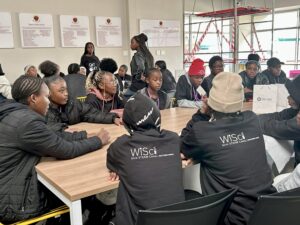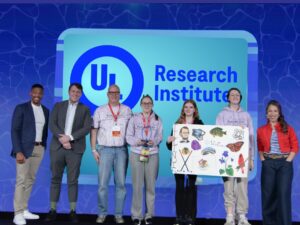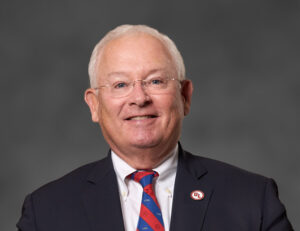Being Inclusive of Women in STEM Means Supporting Women in STEM

By Kelly Keena, Ph.D. senior director, Institute for Research Experiences & Education
During high school commencement season, I often hear about the demand for students planning to go into one of the science, technology, engineering, and math (STEM) fields. After all, data scientists and statisticians are among the fastest-growing occupations in the country.
Still, relatively few women embark on and stay in STEM careers. In fact, adult women comprised more than half of the total U.S. population in 2021, but made up only 35% of the people employed in STEM occupations, according to the “Diversity and STEM: Women, Minorities, and Persons With Disabilities 2023” report released by the National Center for Science and Engineering Statistics in January. The same discrepancy exists, the report notes, for Hispanic, Black, Native American, and Alaska Native people, who collectively comprised 31% of the U.S. population but just 24% of the STEM workforce in 2021.
The societal cost of these discrepancies? Considerable.
Why engaging more women in STEM matters
The number of STEM field jobs has been growing for decades, and the U.S. Bureau of Labor Statistics predicts continued growth in its 2021-2031 projections. Alongside obvious reasons rooted in inclusion and equity, we need more women in STEM to meet that growing demand. But there are other costs. As the NCSES report points out, the unique perceptions that people with varied backgrounds, experiences, and points of view bring to their scientific work help foster innovation and a robust STEM community.
All of which leads to the crucial question — how do we support and then keep women in STEM? It’s complex and systemic. In other words, it’s not the responsibility of individual women to fix this problem. We must develop systems-level solutions.
I am an educator by training and profession. In my previous work in programs both outside of and within the school day, I was committed to addressing the lack of women and other overlooked members of our world in STEM professions. Today, I do that work through the Institute for Research Experiences & Education at UL Research Institutes. Our institute’s central purpose is to help more people thrive in STEM careers by providing greater access to educational and research opportunities.

Pivotal opportunities
In my experience, there are three opportunities to engage, attract, and retain women in the sciences that all too frequently turn into off-ramps.
The first occurs during their early school years. Science education can unintentionally move students from wonder and awe — the lynchpins of engagement in learning — into procedures and memorization that don’t maintain the meaning and relevance of the lessons to the child. This can lead to a lack of engagement, especially around adolescence.
During this period, young people make sense of their world in an altruistic way. Why altruism? Based on a study we are currently conducting, we know students and emerging professionals have a deep passion in helping their communities and society, and they feel they can make a difference through STEM.
The second off-ramp away from STEM may occur between high school and college. Without support, students, especially women, may be missing out on opportunities to build confidence in their new knowledge and skills or their ability to find a well-suited program. This is a critical time in which women need mentors in their chosen field of study, especially those that represent the students’ identities. We know that representation does matter: As the number of women in STEM jobs increased over five decades, an ongoing study with recent findings published in Child Development showed that there was also an increase in the number of students between 5 and 18 years old who drew women when asked to depict a scientist.
Finally, women show higher attrition than men in STEM careers after graduating from a college or university. Workplace culture appears to be a factor. Nearly one-third of women in technical and engineering roles are often the only woman in the room at work, grappling with a culture that discounts their experience and creates obstacles to advancement, according to the 2022 “Women in the Workplace” study conducted by LeanIn.Org and McKinsey & Company.

Changing direction
We can contribute to a solution that turns these off-ramps into on-ramps by inviting every student to experience what STEM really is: a well-rounded, multidisciplinary, solutions-oriented way of learning that becomes more technical and narrower in focus over time.
This begins when we tap into our students’ innate curiosity about the most immediate world. We build competence and confidence by asking young students what lights them up and listening to their responses. We give them ways to explore their world. We let them get dirty and make mistakes. We ask them why and what they think happened when they observe phenomena in the world.
In my science classroom, I had two hand-drawn posters in the front of the room that asked, “So what?” and “Who cares?” While seemingly flippant at first, the posters were there to help remind the students to ask these questions of each lesson. I focused on whether my middle school students could answer why the material they were learning was meaningful and relevant — on whether they could answer “Why is that important?” and “Where did it matter to them?” because science literacy and relevance has never been more important in everyday life. We must enable youth to apply their learning to the real world. By doing this, we encourage students to question — and questions are the fundamental genesis of science.
Educators also may be able to help instill confidence in students as they explore new knowledge and abilities. As I’ve prepared undergraduate and graduate teachers for the science classroom, I’ve noted how each student’s personal experience as a science student was reflected in their attitude. Students who had retained their sense of wonder and curiosity were excited; those with a negative science classroom experience in their personal schooling reacted with trepidation, fear, and timidity.
Those attitudes can be passed along. If professional educators understand the scientific process of questioning, analyzing, and discussion, they’re likely to pass along an attitude of curiosity and inquiry rather than a sense of intimidation. Educators who themselves appreciate science and understand how questions drive the acquisition of knowledge will encourage and welcome students overlooked by STEM in the past — including women — and imbue in them the confidence to succeed in STEM.
Finally, we can help keep women in STEM by creating and maintaining systems that support women beyond the first few years in their early positions following graduate school. The concept of persistence — that is, students’ ability to continue in their STEM pathway — was one that became clear to me as I celebrated the graduation ceremonies of the high schools in districts where I taught. I felt optimistic, given the graduation rates and number of diverse women moving into careers in the STEM fields of their choice after so much hard work. But persistence alone is not always enough. I realized that the support structures for women and others who are not adequately represented in STEM diminished as they moved further away from their transition between high school to college. What happens to those support systems for women specifically, in graduate school and beyond? There are wonderful organizations doing incredible work to bridge this divide. I want UL Research Institutes to be one of them. Our institute is in the process of developing and pilot testing an intern program that will include ongoing support from college to careers.
Our mission at UL Research Institutes is to build the future of safety science, and, with the right on-ramps, that future will be made up of all faces and wonderful, unique perspectives.
PUBLISHED









